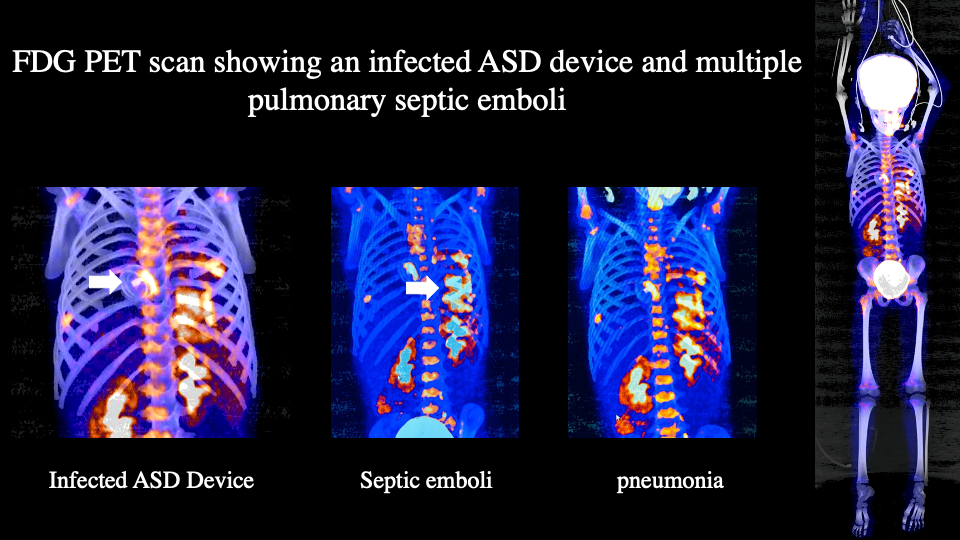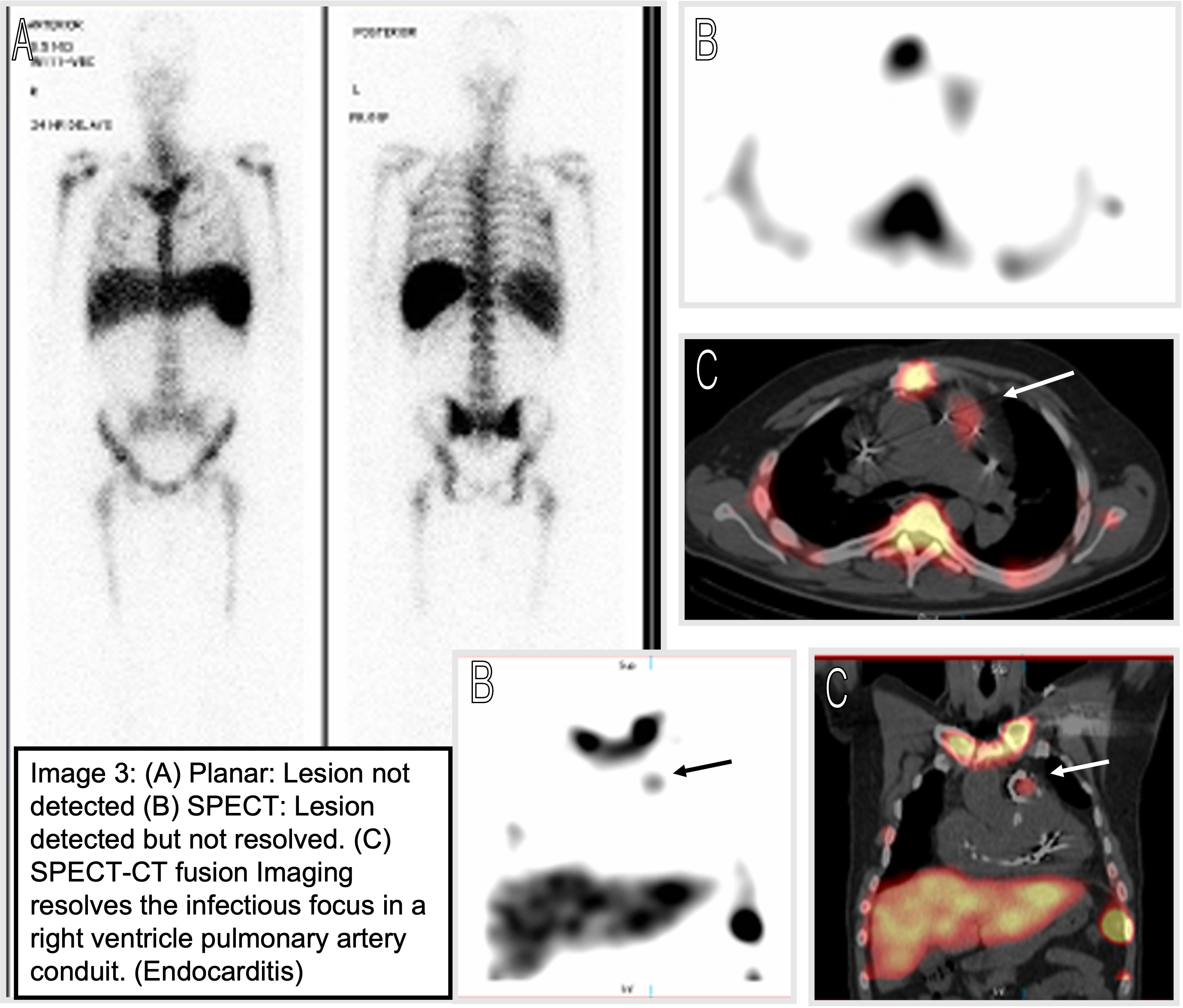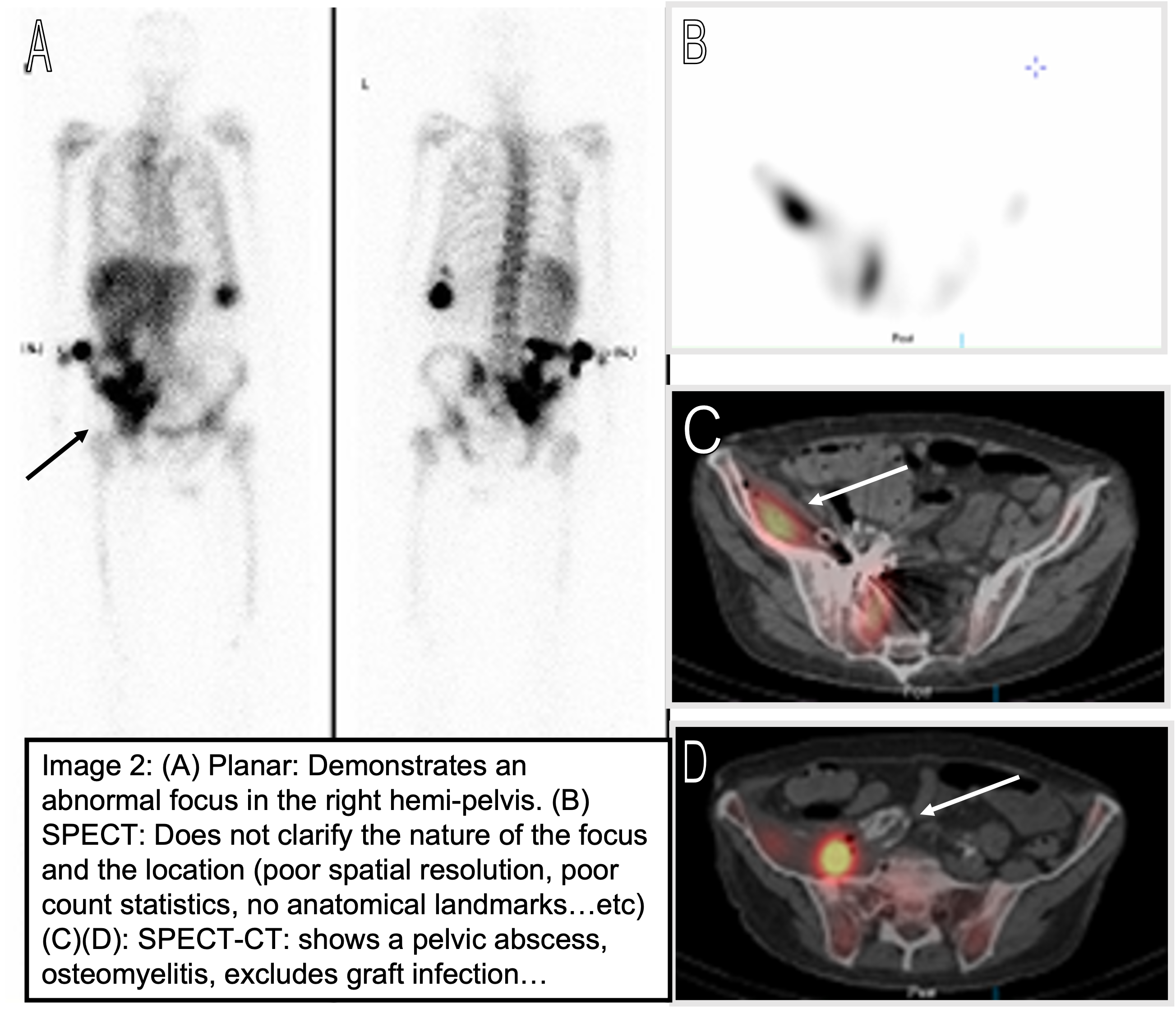[1]
Dietz M,Paulmier B,Berthier F,Civaia F,Mocquot F,Serrano B,Nataf V,Hugonnet F,Faraggi M, An Intravenous 100-mL Lipid Emulsion Infusion Dramatically Improves Myocardial Glucose Metabolism Extinction in Cardiac FDG PET Clinical Practice. Clinical nuclear medicine. 2021 Jun 1
[PubMed PMID: 33630808]
[2]
Gazzilli M,Albano D,Durmo R,Cerudelli E,Mesquita Tinoco C,Bertagna F,Giubbini R, Improvement of diagnostic accuracy of 18fluorine-fluorodeoxyglucose PET/computed tomography in detection of infective endocarditis using a 72-h low carbs protocol. Nuclear medicine communications. 2020 Aug
[PubMed PMID: 32404648]
[3]
Signore A,Jamar F,Israel O,Buscombe J,Martin-Comin J,Lazzeri E, Clinical indications, image acquisition and data interpretation for white blood cells and anti-granulocyte monoclonal antibody scintigraphy: an EANM procedural guideline. European journal of nuclear medicine and molecular imaging. 2018 Sep
[PubMed PMID: 29850929]
[4]
Tagiling N,Mohd-Rohani MF,Wan-Sohaimi WF,Faisham WI,Nawi NM, Combined Techniques of Non-invasive {sup}99m{/sup}Tc-Besilesomab/{sup}99m{/sup}Tc-Sulfur Colloid with Hybrid SPECT/CT Imaging in Characterising Cellulitis from Symptomatic Perimegaprosthetic Infection: A Case Report. Malaysian orthopaedic journal. 2020 Nov;
[PubMed PMID: 33403085]
Level 3 (low-level) evidence
[5]
Frölich A,Knoll G,Bähre M,Neumann C, Diagnosis of chronic osteomyelitis by combined {sup}99m{/sup}Tc-bone and {sup}99m{/sup}Tc-anti-granulocyte scintigraphy. Nuklearmedizin. Nuclear medicine. 2016 Dec 6;
[PubMed PMID: 27922152]
[6]
Frölich A,Schwarze I,Neumann C, Polymyalgia rheumatica detected by SPECT/CT using {sup}99m{/sup}Tc-labeled monoclonal antibody Fab'-fragments. Nuklearmedizin. Nuclear medicine. 2017 Feb 14;
[PubMed PMID: 28004845]
[7]
Bouter C,Meller B,Sahlmann CO,Meller J, {sup}99m{/sup}Tc-Besilesomab-SPECT/CT in Infectious Endocarditis: Upgrade of a Forgotten Method? Frontiers in medicine. 2019;
[PubMed PMID: 30873410]
[8]
Schiavo R,Ricci A,Pontillo D,Bernardini G,Melacrinis FF,Maccafeo S, Implantable cardioverter-defibrillator lead infection detected by 99mTc-sulesomab single-photon emission computed tomography/computed tomography 'fusion' imaging. Journal of cardiovascular medicine (Hagerstown, Md.). 2009 Nov;
[PubMed PMID: 19680133]
[9]
Boudjelal A,Elmoataz A,Attallah B,Messali Z, A Novel Iterative MLEM Image Reconstruction Algorithm Based on Beltrami Filter: Application to ECT Images. Tomography (Ann Arbor, Mich.). 2021 Jul 28
[PubMed PMID: 34449726]
[10]
Nakamura Y,Kangai Y,Abe T,Nakahara Y, [Improvement of Standardized Uptake Value Accuracy in the {sup}99m{/sup}Tc Body SPECT and SPECT/CT: Optimization of the Phantom for Calculating Becquerel Calibration Factor and Correction Method]. Nihon Hoshasen Gijutsu Gakkai zasshi. 2021;
[PubMed PMID: 34544916]
[11]
Zhang R,Wang M,Zhou Y,Wang S,Shen Y,Li N,Wang P,Tan J,Meng Z,Jia Q, Impacts of acquisition and reconstruction parameters on the absolute technetium quantification of the cadmium-zinc-telluride-based SPECT/CT system: a phantom study. EJNMMI physics. 2021 Sep 26
[PubMed PMID: 34568990]
[12]
Kwok HM,Luk WH,Cheng LF,Pan NY,Chan HF,Ma JK, Gallium-67 Scan with Single Photon Emission Computed Tomography for the Evaluation and Monitoring of Infected Abdominal Aortic Aneurysms: A 10-Year Case Series. Vascular specialist international. 2021 Jun 29;
[PubMed PMID: 34183473]
Level 2 (mid-level) evidence
[13]
Kubota K,Tanaka N,Miyata Y,Ohtsu H,Nakahara T,Sakamoto S,Kudo T,Nishiyama Y,Tateishi U,Murakami K,Nakamoto Y,Taki Y,Kaneta T,Kawabe J,Nagamachi S,Kawano T,Hatazawa J,Mizutani Y,Baba S,Kirii K,Yokoyama K,Okamura T,Kameyama M,Minamimoto R,Kunimatsu J,Kato O,Yamashita H,Kaneko H,Kutsuna S,Ohmagari N,Hagiwara A,Kikuchi Y,Kobayakawa M, Comparison of {sup}18{/sup}F-FDG PET/CT and {sup}67{/sup}Ga-SPECT for the diagnosis of fever of unknown origin: a multicenter prospective study in Japan. Annals of nuclear medicine. 2021 Jan
[PubMed PMID: 33037581]
[14]
Kimura Y,Seguchi O,Mochizuki H,Iwasaki K,Toda K,Kumai Y,Kuroda K,Nakajima S,Tateishi E,Watanabe T,Matsumoto Y,Fukushima S,Kiso K,Yanase M,Fujita T,Kobayashi J,Fukushima N, Role of Gallium-SPECT-CT in the Management of Patients With Ventricular Assist Device-Specific Percutaneous Driveline Infection. Journal of cardiac failure. 2019 Oct;
[PubMed PMID: 31454687]
[15]
Jamar F, Buscombe J, Chiti A, Christian PE, Delbeke D, Donohoe KJ, Israel O, Martin-Comin J, Signore A. EANM/SNMMI guideline for 18F-FDG use in inflammation and infection. Journal of nuclear medicine : official publication, Society of Nuclear Medicine. 2013 Apr:54(4):647-58. doi: 10.2967/jnumed.112.112524. Epub 2013 Jan 28
[PubMed PMID: 23359660]
[16]
Bombardieri E,Aktolun C,Baum RP,Bishof-Delaloye A,Buscombe J,Chatal JF,Maffioli L,Moncayo R,Mortelmans L,Reske SN, 67Ga scintigraphy: procedure guidelines for tumour imaging. European journal of nuclear medicine and molecular imaging. 2003 Dec;
[PubMed PMID: 14989225]
[17]
Seabold JE,Palestro CJ,Brown ML,Datz FL,Forstrom LA,Greenspan BS,McAfee JG,Schauwecker DS,Royal HD, Procedure guideline for gallium scintigraphy in inflammation. Society of Nuclear Medicine. Journal of nuclear medicine : official publication, Society of Nuclear Medicine. 1997 Jun;
[PubMed PMID: 9189159]
[18]
Al-Suqri B,Al-Bulushi N, Gallium-67 Scintigraphy in the Era of Positron Emission Tomography and Computed Tomography: Tertiary centre experience. Sultan Qaboos University medical journal. 2015 Aug;
[PubMed PMID: 26357553]
[19]
Djekidel M,Brown RK,Piert M, Benefits of hybrid SPECT/CT for (111)In-oxine- and Tc-99m-hexamethylpropylene amine oxime-labeled leukocyte imaging. Clinical nuclear medicine. 2011 Jul
[PubMed PMID: 21637042]
[20]
Richter WS,Ivancevic V,Meller J,Lang O,Le Guludec D,Szilvazi I,Amthauer H,Chossat F,Dahmane A,Schwenke C,Signore A, 99mTc-besilesomab (Scintimun) in peripheral osteomyelitis: comparison with 99mTc-labelled white blood cells. European journal of nuclear medicine and molecular imaging. 2011 May;
[PubMed PMID: 21321791]
[21]
Losman MJ,DeJager RL,Monestier M,Sharkey RM,Goldenberg DM, Human immune response to anti-carcinoembryonic antigen murine monoclonal antibodies. Cancer research. 1990 Feb 1;
[PubMed PMID: 2297721]
[22]
Gemmel F,Van den Broeck B,Vanelstraete S,Van Innis B,Huysse W, Hybrid imaging of complicating osteomyelitis in the peripheral skeleton. Nuclear medicine communications. 2021 Sep 1;
[PubMed PMID: 33852533]
[23]
Gratz S,Reize P,Pfestroff A,Höffken H, Intact versus fragmented 99mTc-monoclonal antibody imaging of infection in patients with septically loosened total knee arthroplasty. The Journal of international medical research. 2012;
[PubMed PMID: 22971485]
[24]
Jacobs J,Coorevits L,Verscuren R,Frans G,Schrijvers R,Breynaert C, Severe Anaphylaxis on Murine Antibodies in Sulesomab. Journal of investigational allergology
[PubMed PMID: 33541849]
[25]
Li Q, Tian R, Sun X. More Evidence Is Warranted to Establish the Role of 18FDG-PET/CT in Fever of Unknown Origin (FUO) Investigations Among Children. Clinical infectious diseases : an official publication of the Infectious Diseases Society of America. 2021 Nov 2:73(9):e2842-e2844. doi: 10.1093/cid/ciaa1574. Epub
[PubMed PMID: 33064795]
[26]
Pijl JP, Kwee TC, Legger GE, Peters HJH, Armbrust W, Schölvinck EH, Glaudemans AWJM. Role of FDG-PET/CT in children with fever of unknown origin. European journal of nuclear medicine and molecular imaging. 2020 Jun:47(6):1596-1604. doi: 10.1007/s00259-020-04707-z. Epub 2020 Feb 7
[PubMed PMID: 32030452]
[27]
Shimizu M, Ikawa Y, Mizuta M, Takakura M, Inoue N, Nishimura R, Yachie A. FDG-PET in macrophage activation syndrome associated with systemic juvenile idiopathic arthritis. Pediatrics international : official journal of the Japan Pediatric Society. 2017 Apr:59(4):509-511. doi: 10.1111/ped.13238. Epub
[PubMed PMID: 28401744]
[28]
Shimizu M, Saikawa Y, Yachie A. Role of 18-fluoro-2-deoxyglucose positron emission tomography in detecting acute inflammatory lesions of non-bacterial osteitis in patients with a fever of unknown origin: A comparative study of 18-fluoro-2-deoxyglucose positron emission tomography, bone scan, and magnetic resonance imaging. Modern rheumatology. 2018 Nov:28(6):1058-1062. doi: 10.1080/14397595.2016.1193112. Epub 2016 Jun 20
[PubMed PMID: 27321232]
Level 2 (mid-level) evidence
[29]
Garg G, DaSilva R, Bhalakia A, Milstein DM. Utility of fluorine-18-fluorodeoxyglucose positron emission tomography/computed tomography in a child with chronic granulomatous disease. Indian journal of nuclear medicine : IJNM : the official journal of the Society of Nuclear Medicine, India. 2016 Jan-Mar:31(1):62-4. doi: 10.4103/0972-3919.172366. Epub
[PubMed PMID: 26917900]
[30]
Chang L, Cheng MF, Jou ST, Ko CL, Huang JY, Tzen KY, Yen RF. Search of Unknown Fever Focus Using PET in Critically Ill Children With Complicated Underlying Diseases. Pediatric critical care medicine : a journal of the Society of Critical Care Medicine and the World Federation of Pediatric Intensive and Critical Care Societies. 2016 Feb:17(2):e58-65. doi: 10.1097/PCC.0000000000000601. Epub
[PubMed PMID: 26649939]
[31]
del Rosal T,Goycochea WA,Méndez-Echevarría A,García-Fernández de Villalta M,Baquero-Artigao F,Coronado M,Marín MD,Albajara L, ¹⁸F-FDG PET/CT in the diagnosis of occult bacterial infections in children. European journal of pediatrics. 2013 Aug;
[PubMed PMID: 23479196]
[32]
Jasper N,Däbritz J,Frosch M,Loeffler M,Weckesser M,Foell D, Diagnostic value of [(18)F]-FDG PET/CT in children with fever of unknown origin or unexplained signs of inflammation. European journal of nuclear medicine and molecular imaging. 2010 Jan
[PubMed PMID: 19526234]
[33]
Kawamura J, Ueno K, Taimura E, Matsuba T, Imoto Y, Jinguji M, Kawano Y. Case Report: (18)F-FDG PET-CT for Diagnosing Prosthetic Device-Related Infection in an Infant With CHD. Frontiers in pediatrics. 2021:9():584741. doi: 10.3389/fped.2021.584741. Epub 2021 Mar 8
[PubMed PMID: 33763393]
Level 3 (low-level) evidence
[34]
Aslanidis IP, Pursanova DM, Mukhortova OV, Shurupova IV, Ekaeva IV, Arakelyan VS, Golukhova EZ, Mironenko VA, Garmanov SV, Popov DA. [18F-fluorodeoxyglucose PET/CT in the diagnosis of vascular graft infection]. Khirurgiia. 2021:(2):58-66. doi: 10.17116/hirurgia202102158. Epub
[PubMed PMID: 33570356]
[35]
Jiménez D, Soto ME, Martínez-Martínez LA, Hernández-López D, Lerma C, Barragán-Garfias JA, Pérez-Torres I, Hernández-Lemus E, Guarner-Lans V. Assessment of inflammatory activity in Takayasu's arteritis: performance of clinical scores and common biomarkers versus 18F-FDG PET/CT. Clinical and experimental rheumatology. 2021 Sep-Oct:39(5):1011-1020. doi: 10.55563/clinexprheumatol/a71bzh. Epub 2020 Oct 29
[PubMed PMID: 33124558]
[36]
Treglia G. Diagnostic Performance of (18)F-FDG PET/CT in Infectious and Inflammatory Diseases according to Published Meta-Analyses. Contrast media & molecular imaging. 2019:2019():3018349. doi: 10.1155/2019/3018349. Epub 2019 Jul 25
[PubMed PMID: 31427907]
[37]
Chen W, Sajadi MM, Dilsizian V. Merits of FDG PET/CT and Functional Molecular Imaging Over Anatomic Imaging With Echocardiography and CT Angiography for the Diagnosis of Cardiac Device Infections. JACC. Cardiovascular imaging. 2018 Nov:11(11):1679-1691. doi: 10.1016/j.jcmg.2018.08.026. Epub
[PubMed PMID: 30409329]
[38]
Diemberger I, Bonfiglioli R, Martignani C, Graziosi M, Biffi M, Lorenzetti S, Ziacchi M, Nanni C, Fanti S, Boriani G. Contribution of PET imaging to mortality risk stratification in candidates to lead extraction for pacemaker or defibrillator infection: a prospective single center study. European journal of nuclear medicine and molecular imaging. 2019 Jan:46(1):194-205. doi: 10.1007/s00259-018-4142-9. Epub 2018 Sep 8
[PubMed PMID: 30196365]
[39]
Blanc P, Bonnet E, Giordano G, Monteil J, Salabert AS, Payoux P. The use of labelled leucocyte scintigraphy to evaluate chronic periprosthetic joint infections: a retrospective multicentre study on 168 patients. European journal of clinical microbiology & infectious diseases : official publication of the European Society of Clinical Microbiology. 2019 Sep:38(9):1625-1631. doi: 10.1007/s10096-019-03587-y. Epub 2019 Jun 20
[PubMed PMID: 31218592]
Level 2 (mid-level) evidence
[40]
Loessel C,Mai A,Starke M,Vogt D,Stichling M,Willy C, Value of antigranulocyte scintigraphy with Tc-99m-sulesomab in diagnosing combat-related infections of the musculoskeletal system. BMJ military health. 2021 Feb;
[PubMed PMID: 30787111]
[41]
Albano D,Bosio G,Paghera B,Bertagna F, Comparison Between 99mTc-Sulesomab and 18F-FDG PET/CT in a Patient With Suspected Prosthetic Joint Infection. Clinical nuclear medicine. 2016 Jun;
[PubMed PMID: 27055130]
[42]
Lawal IO,Kleyhans J,Mokoala KMG,Vorster M,Ebenhan T,Zeevaart JR,Sathekge MM, Single Photon Emission Tomography in the Diagnostic Assessment of Cardiac and Vascular Infectious Diseases. Current radiopharmaceuticals. 2020 Jun 21;
[PubMed PMID: 32564768]
[43]
Puius YA,Parkar F,Tlamsa AP,Nistico JA,Muggia VA,Minamoto GY,Jorde UP,Goldstein DJ,Moadel RM, Gallium-67 Single-Photon Emission Computed Tomography Affects Management of Infections of Left Ventricular Assist Devices. ASAIO journal (American Society for Artificial Internal Organs : 1992). 2021 Jul 1;
[PubMed PMID: 33196482]
[44]
McWilliams ET,Yavari A,Raman V, Aortic root abscess: multimodality imaging with computed tomography and gallium-67 citrate single-photon emission computed tomography/computed tomography hybrid imaging. Journal of cardiovascular computed tomography. 2011 Mar-Apr;
[PubMed PMID: 21130063]
[45]
Pretet V,Blondet C,Ruch Y,Martinez M,El Ghannudi S,Morel O,Hansmann Y,Schindler TH,Imperiale A, Advantages of 18F-FDG PET/CT Imaging over Modified Duke Criteria and Clinical Presumption in Patients with Challenging Suspicion of Infective Endocarditis. Diagnostics (Basel, Switzerland). 2021 Apr 18;
[PubMed PMID: 33919643]
[46]
Diez AIG,Fuster D,Morata L,Torres F,Garcia R,Poggio D,Sotes S,Del Amo M,Isern-Kebschull J,Pomes J,Soriano A,Brugnara L,Tomas X, Comparison of the diagnostic accuracy of diffusion-weighted and dynamic contrast-enhanced MRI with {sup}18{/sup}F-FDG PET/CT to differentiate osteomyelitis from Charcot neuro-osteoarthropathy in diabetic foot. European journal of radiology. 2020 Nov;
[PubMed PMID: 33032207]
[47]
Casali M,Lauri C,Altini C,Bertagna F,Cassarino G,Cistaro A,Erba AP,Ferrari C,Mainolfi CG,Palucci A,Prandini N,Baldari S,Bartoli F,Bartolomei M,D'Antonio A,Dondi F,Gandolfo P,Giordano A,Laudicella R,Massollo M,Nieri A,Piccardo A,Vendramin L,Muratore F,Lavelli V,Albano D,Burroni L,Cuocolo A,Evangelista L,Lazzeri E,Quartuccio N,Rossi B,Rubini G,Sollini M,Versari A,Signore A, State of the art of {sup}18{/sup}F-FDG PET/CT application in inflammation and infection: a guide for image acquisition and interpretation. Clinical and translational imaging. 2021 Jul 10;
[PubMed PMID: 34277510]
[48]
Lee SJ,Won KS,Choi HJ,Choi YY, Early-Phase SPECT/CT for Diagnosing Osteomyelitis: A Retrospective Pilot Study. Korean journal of radiology. 2021 Apr;
[PubMed PMID: 33289359]
Level 2 (mid-level) evidence
[49]
Freesmeyer M,Stecker FF,Schierz JH,Hofmann GO,Winkens T, First experience with early dynamic (18)F-NaF-PET/CT in patients with chronic osteomyelitis. Annals of nuclear medicine. 2014 May;
[PubMed PMID: 24474597]
[50]
Brown TL,Spencer HJ,Beenken KE,Alpe TL,Bartel TB,Bellamy W,Gruenwald JM,Skinner RA,McLaren SG,Smeltzer MS, Evaluation of dynamic [18F]-FDG-PET imaging for the detection of acute post-surgical bone infection. PloS one. 2012;
[PubMed PMID: 22860021]
[51]
Stecker FF,Schierz JH,Opfermann T,Driesch D,Hofmann GO,Winkens T,Freesmeyer M, Early dynamic 18F-FDG PET/CT to diagnose chronic osteomyelitis following lower extremity fractures. A pilot study. Nuklearmedizin. Nuclear medicine. 2014;
[PubMed PMID: 23780221]
Level 3 (low-level) evidence
[52]
Lee JW,Yu SN,Yoo ID,Jeon MH,Hong CH,Shim JJ,Chang SH,Lee SM, Clinical application of dual-phase F-18 sodium-fluoride bone PET/CT for diagnosing surgical site infection following orthopedic surgery. Medicine. 2019 Mar;
[PubMed PMID: 30882648]
[53]
Christersson A,Larsson S,Sörensen J, Presurgical localization of infected avascular bone segments in chronic complicated posttraumatic osteomyelitis in the lower extremity using dual-tracer PET/CT. EJNMMI research. 2018 Jul 21;
[PubMed PMID: 30032355]
[54]
La Fontaine J,Bhavan K,Lam K,Van Asten S,Erdman W,Lavery LA,Öz OK, Comparison Between Tc-99m WBC SPECT/CT and MRI for the Diagnosis of Biopsy-proven Diabetic Foot Osteomyelitis. Wounds : a compendium of clinical research and practice. 2016 Aug;
[PubMed PMID: 27560470]
[55]
Lauri C,Tamminga M,Glaudemans AWJM,Juárez Orozco LE,Erba PA,Jutte PC,Lipsky BA,IJzerman MJ,Signore A,Slart RHJA, Detection of Osteomyelitis in the Diabetic Foot by Imaging Techniques: A Systematic Review and Meta-analysis Comparing MRI, White Blood Cell Scintigraphy, and FDG-PET. Diabetes care. 2017 Aug;
[PubMed PMID: 28733376]
Level 1 (high-level) evidence
[56]
Delcourt A,Huglo D,Prangere T,Benticha H,Devemy F,Tsirtsikoulou D,Lepeut M,Fontaine P,Steinling M, Comparison between Leukoscan (Sulesomab) and Gallium-67 for the diagnosis of osteomyelitis in the diabetic foot. Diabetes
[PubMed PMID: 15959418]
[57]
Heidari N,Oh I,Li Y,Vris A,Kwok I,Charalambous A,Rogero R, What Is the Best Method to Differentiate Acute Charcot Foot From Acute Infection? Foot
[PubMed PMID: 31322932]
[58]
Basu S, Chryssikos T, Houseni M, Scot Malay D, Shah J, Zhuang H, Alavi A. Potential role of FDG PET in the setting of diabetic neuro-osteoarthropathy: can it differentiate uncomplicated Charcot's neuroarthropathy from osteomyelitis and soft-tissue infection? Nuclear medicine communications. 2007 Jun:28(6):465-72
[PubMed PMID: 17460537]



